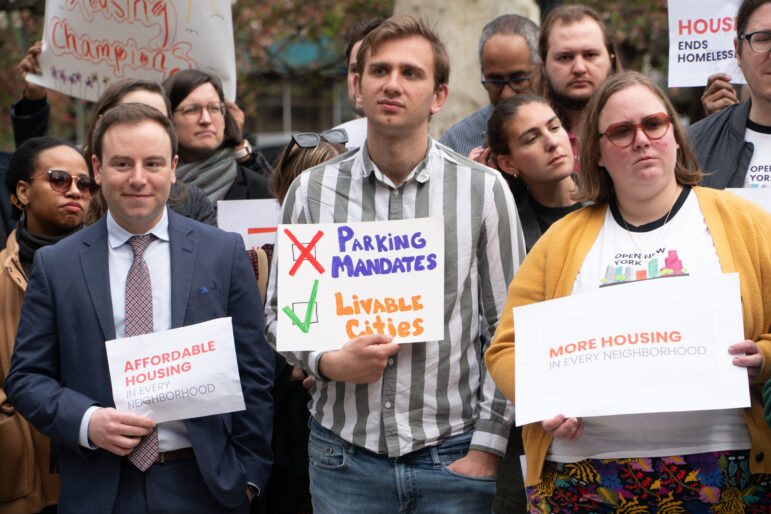
Public Review to Begin for Mayor’s ‘City of Yes’ Housing Plan, as Affordability Details Emerge
Introduced in September as the third column in Adams’ City of Yes initiative—following separate proposals related to climate and commercial businesses—the City of Yes for Housing Opportunity is a broad plan that seeks to tackle the housing crisis with various zoning changes.
Chris Janaro
Supporters turned out Wednesday for a rally outside City Hall to kick of the City of Yes for Housing Opportunity.
Mayor Eric Adams’ key initiative to address the city’s housing crisis will soon enter the public review process after long-awaited details on affordability levels were announced on Thursday.
Introduced in September as the third column in Adams’ City of Yes Initiative—following separate proposals related to climate and commercial businesses—the City of Yes for Housing Opportunity is a broad plan that seeks to tackle the housing crisis with various zoning changes.
One component would let developers build about 20 percent more housing than otherwise allowed—so long as the extra units are income-restricted.
In order to qualify for the density bonus, dubbed the Universal Affordability Preference (UAP), the additional units need to be permanently affordable to New Yorkers earning an average of 60 percent of the Area Median Income (AMI)—about $76,260 for a family of three.
That targets a lower income threshold than the city’s existing Voluntary Inclusionary (VIH) Housing program, in which developers in certain neighborhoods can build more in exchange for including a portion of apartments for households at 80 percent AMI, or $101,680 for a three-person household.
“We believe that we can and should do better than the current 80 percent AMI,” Department of City Planning Director Daniel Garodnick said at a press conference in September when first unveiling the plan.
Additionally, the UAP would allow the “deep affordability” option within Mandatory Inclusionary Housing (MIH)—a program passed under former Mayor de Blasio, which requires upzoned projects include a portion of income-restricted units—to be implemented on its own, without needing to be paired with other MIH options at higher AMI levels. The deep affordability option mandates that 20 percent of a development’s units be accessible to New Yorkers earning 40 percent of the AMI, or roughly $50,840 for a family of three.
In her most recent State of the City address, Council Speaker Adrienne Adams called specifically for that change. In a statement Thursday, she praised the administration’s latest proposal, which will eventually come before the Council for a vote.
“The affordability levels in the new text for the Zoning for Housing Opportunity (ZHO) better reflect the growing need for prioritizing deeper affordability, and I welcome these changes,” she said. “Once the citywide text amendment makes its way through the public review process, the Council looks forward to fully reviewing it.”
“Averaging at 60% AMI IS noteworthy!” said Rachel Fee, executive director of the New York Housing Conference, in a post on the X platform formerly known as Twitter.
“If Albany lands somewhere higher on 421a income levels, this will be very meaningful in both creating more affordable housing and getting deeper affordability,” she added in her post, referring to a lapsed property tax benefit for developers to encourage affordable housing construction. 421-a expired in June 2022, and discussions around its revival, along with potential tenant protections like good cause, have dominated policy discussions at the state level this year.
However, some think the City of Yes plan could have embraced even deeper affordability.
In an interview with City Limits, Emily Goldstein, director of organizing and advocacy at the Association for Neighborhood and Housing Development (ANHD), said 60 percent of AMI still excludes many of the people who most need affordable housing in the city.
“We’re not inherently opposed to development in general. But it’s something I do think it’s important to distinguish between,” she said. “Are we talking about an affordable housing program? Or are we talking about a general housing supply program? And the high-density piece of this is more the latter than the former.”
Last year, just 1.41 percent of apartments across the five boroughs were available to renters, the lowest rate in decades, the NYC Housing and Vacancy Survey found—and homes were especially scarce for the lowest income households, with just 0.39 percent of units renting for under $1,100 vacant and available in 2023.
Other critics of the mayor’s plan voiced concerns over a one-size-fits-all approach to creating more homes across the five boroughs.
“They’re taking a large text amendment that would change zoning, not realizing that it doesn’t fit every single community throughout the city,” said City Councilmember Joann Ariola, representing District 32 in Queens, which includes the Howard Beach and South Ozone Park neighborhoods. “Why didn’t they make this into smaller pieces so that we could vote on them separately to see what would fit which community?”
The public review process for City of Yes expedites the typical public review timeline by having borough presidents and community boards weigh in simultaneously. They’ll have two months to examine the proposal and suggest changes.
After that, there is a brief period for further adjustments before the plan reaches the City Planning Commission for a binding vote before going before the City Council, where they too can approve, modify, or deny the proposal, which is anticipated to happen before the end of the year, according to sources at the Department of City Planning (DCP).
The mayor has pitched his plan as an effort to build “a little more housing in every neighborhood,” noting inequities in new development across the city.
“There are a lot of neighborhoods that have frankly been not doing any development and that have been allowed by the current state of affairs to remain very exclusionary,” said Goldstein.
“We do think that there are a lot of aspects of this proposal, more for lower-density neighborhoods, that will help to combat that issue and ensure a more equitable distribution of development in the city,” she added.
In addition to the UAP component, the City of Yes aims to address the city’s housing crisis by more easily allowing conversions of underused non-residential spaces, such as vacant offices, into housing, and reintroducing mixed-use zoning to enable apartments above businesses in low-density areas.
Additionally, the plan seeks to eliminate mandatory off-street parking requirements for new residential projects, reducing costs and increasing housing production. It would legalize accessory dwelling units (ADUs) such as garage conversions, and ease zoning limitations for faith-based organizations and universities to more easily convert their properties into homes.
DCP sources indicate that the City of Yes for Housing Opportunity will enter formal public review toward the end of this month.
To reach the reporter behind this story, contact Chris@citylimits.org. To reach the editor, contact Jeanmarie@citylimits.org
Want to republish this story? Find City Limits’ reprint policy here.
The post Public Review to Begin for Mayor’s ‘City of Yes’ Housing Plan, as Affordability Details Emerge appeared first on City Limits.


